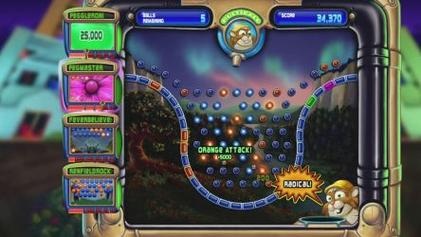Realtime Rendering
Assignment 3
Assessment: 33%
Deadline: Fri 18/10/2019 9pm (end week 12)
Changes and Clarifications:
Aims
This assignment is intended to have students learn about game
physics and collisions, and to write a small game using mechanics
based on such. It may be done in pairs.
Problem Description
Many games have been written which have 'game mechanics' based
on relatively simple physics and collisions, and were core to many early
games - including one of the very first computer games
Spacewar!.
Highly successful games based on simple physics
continue to emerge.
Osmos, which
uses inelastic collisions between circular/spherical objects.
Angry Birds (and
locally produced Catapult King
by Wicked Witch
Software might be of interest), uses projectile
motion and collisions.
This year the final assignment is
based on Peggle
which uses projectile motion and collisions.
The assignment is to write a game similar to Peggle, involving
collision detection between a moving ball and fixed position pegs.
However, there are variations including making the pegs shapes
be different polygons - triangles, squares, pentagons etc -
and be rotating.

(from wikipedia)
And youtube video of gameplay
Marking Guide/Rubric
Assessment is primarily based on functionality, as below, although
code quality is also taken in to account.
PA:
-
A rectangular arena with circular pegs and a falling ball with
constant speed which collides with and bounces off pegs and
walls, with working collision detection and response.
-
A catcher at the bottom.
-
The ball should fall with a constant acceleration towards the bottom,
and either fall out of the bottom of the arena or be caught by
the catcher.
CR:
-
The pegs should light up when hit.
-
A predicted ball trajectory should be visualised, including
collisions. For gameplay this should be limited two deep.
-
A mode which shows the complete
predicted trajectory of the ball, which the actual
trajectory will however deviate from due to fundamental nature
of numerical integration and prediction.
-
Use simple plain colours for rendering, including the visualisation.
-
Use brute force collision detection whereby all pegs are checked.
DI, features to be considered once a basic assigment as
above has been completed:
-
Polygonal pegs: rectangles, triangles, pentagons and hexagons.
-
In the visualisation include highlighting of the edge of the
polygonal peg the ball bounces off
-
Handle collisions with corners (vertices) by assuming circular
shapes.
HD, extensions and enhancements of which many are possible,
for example:
-
Use a core OpenGL context which means compatibility
and "boots and all" including deprecated features are not
allowed. No immediate mode.
-
Use a core OpenGL ES 3 context, which is used in many mobile
devices, and the basis for WebGL 2, but can be used on the
desktop too. Use SDL and target an Android phone with ES3 support.
-
Particle effects.
-
Add moving features, which may collide.
-
Improve the collision detection performance by using a uniform
grid.
-
Implement different shaped arenas, e.g. a circular arena/world.
-
Allow different arenas or features made of bricks which get knocked out.
-
Using shaders to render the ball, pegs and bricks, treating
them as either quads or points (with point size). Further, use
a fragment shader to apply an animated procedural texture.
-
Explore deeper game design changes, e.g. adding sections where
pegs are not fixed but moving and colliding, or where pegs are
rotating randomly
-
Use analytic cirle-parabola collision detection for trajectory
prediction.
-
Other features or improvements of your own. Best to discuss
with the lecturer first.
Note: subject to (minor) change.

